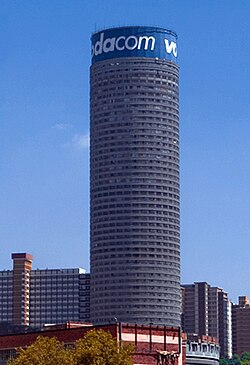Ponte City
| Ponte City Apartments | |
|---|---|
 | |
 | |
| General information | |
| Type | Residential |
| Location | Hillbrow neighbourhood of Johannesburg, South Africa |
| Coordinates | 26°11′26″S 28°3′25.5″E / 26.19056°S 28.057083°E |
| Completed | 1975 |
| Height | |
| Roof | 173 m (567.6 ft) |
| Technical details | |
| Floor count | 54-story |
| Design and construction | |
| Architect(s) | Designed by Manfred Hermer |
Ponte City is a skyscraper in the Hillbrow neighbourhood of Johannesburg, South Africa. It was built in 1975 to a height of 173 m (567.6 ft), making it the tallest residential skyscraper in Africa. The 54-story building is cylindrical, with an open center allowing additional light into the apartments. The center space is known as "the core" and rises above an uneven rock floor. When built, Ponte City was seen as an extremely desirable address due to its views over all of Johannesburg and its surroundings. The sign on top of the building is the largest sign in the southern hemisphere.[1] It currently advertises the South African mobile phone company Vodacom.[2]
History
The principal designer of Ponte was Mannie Feldman, working in a team together with Manfred Hermer and Rodney Grosskopf.[3][4] Rodney Grosskopff recalled the decision to make the building circular, the first cylindrical skyscraper in Africa.[5] At the time, Johannesburg bylaws required kitchens and bathrooms to have a window, so Grosskopff designed the building with a hollow interior, allowing light to enter the apartments from both sides.[5] At the bottom of the immense building were retail stores and initial plans were to include an indoor ski slope on the 32,000-square-foot (3,000 m2) inner core floor.[5] The building was so tall because developers wanted a large number of units but only had limited land to build on.[5] The building is located 35 minutes from the OR Tambo International Airport and almost within walking distance of the innercity with theatres like the Market and the Civic within 5 km (3.1 mi).[2]
Decay
During the late 80s gang activity had caused the crime rate to soar at the tower and the surrounding neighbourhood.[2] By the 1990s, after the end of apartheid, many gangs moved into the building and it became extremely unsafe. Ponte City became symbolic of the crime and urban decay gripping the once cosmopolitan Hillbrow neighborhood. The core filled with debris five stories high as the owners left the building to decay.[5] There were even proposals in the mid-1990s to turn the building into a highrise prison.[2] In 2001 Trafalgar Properties took over management of the building and began making some much needed changes to the building.[6]
New Ponte

In May 2007 Ponte changed ownership and a re-development project New Ponte was put in motion. David Selvan and Nour Addine Ayyoub under Ayyoub's company, Investagain, planned to totally revitalize the building.[7] The planned development would have contained 467 residential units, retail and leisure-time areas. Over the next few years, the Johannesburg Development Agency planned to invest about R900-million in the areas around Ponte City such as the Ellis Park Precinct project, as well as an upgrade of Hillbrow and Berea partly in preparation for the 2010 FIFA World Cup.
The sub-prime crisis caused the banks not to provide the funding required to finish the revitalisation, the project was cancelled and ownership was given back to the Kempston group.[7] The building is currently owned and operated by the Kempston group.
In the arts
Movies
- In February 2007 director Danny Boyle (Trainspotting, 28 Days Later, and Slumdog Millionaire) announced his intention to film a thriller set in the tower.[8]
- One of the final shots of the 2009 film District 9 is of the tower.[9]
- Director Philip Bloom dedicated a documentary film titled Ponte Tower.
- The movie Dredd (2012) takes place primarily in a mega city which contains large living places eerily similar to Ponte. In the movie, the city contains retail stores on the first floor and has been taken over by gangs.
Books
- German writer Norman Ohler used the Ponte as the setting for his book Stadt des Goldes, "Ponte sums up all the hope, all the wrong ideas of modernism, all the decay, all the craziness of the city. It is a symbolic building, a sort of white whale, it is concrete fear, the tower of Babel, and yet it is strangely beautiful".[10]
Photography
- South African photographer Mikhael Subotzky and British artist Patrick Waterhouse won the Discovery award at the Rencontres d'Arles photography festival in 2011 for their three-year project "Ponte City", photographing the residents, interiors and exteriors of the building, and which produced a series of giant tableaux, made up of hundreds of contact sheets, presented in towering light boxes.[11]
References
- ^ "Ponte City Apartments". Emporis. 2009. Retrieved November 21, 2009.
- ^ a b c d Davie, (November 9, 2007). "Ponte: revival of a Joburg icon". pub. Retrieved November 21, 2009.
{{cite web}}: CS1 maint: extra punctuation (link) - ^ Chipkin, Clive, Johannesburg in Transition, STE Publishers, 2008
- ^ Editors note in Housing in Southern Africa, 2006, http://ftp.shf.org.za/hisa_0601.pdf
- ^ a b c d e Hanes, Stephanie (February 12, 2008). "Ponte City – a South African landmark – rises again". The Christian Science Monitor. Retrieved November 21, 2009.
- ^ Redmond, Gillian (January 10, 2003). "Johannesburg Landmarks". Randburg Sun. Amethyst.co.za. Retrieved November 21, 2009.
- ^ a b Pampalone, Tania (December 16, 2008). "Ponte project crashes". Mail & Guardian Online. Retrieved November 21, 2009.
- ^ Danny Boyle interview. BBC - Film Network.
- ^ Sailer, Steve (2009-08-21). "Neill Blomkamp's Giant Apartheid Metaphor". iSteve.com. Retrieved 2009-08-23.
{{cite web}}: Italic or bold markup not allowed in:|publisher=(help) - ^ Ohler, Norman. Stadt des Goldes (in German) (April 1, 2002 ed.). Rowohlt Tb. ISBN 3-499-22727-4.- Total pages: 253
- ^ Sean O'Hagan, "Tower blocks and tomes dominate the Rencontres d'Arles", The Guardian, 11 July 2011
